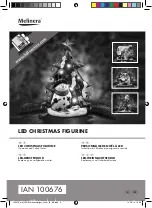
6
- 16
2WAY SYSTEM
Trouble Diagnosis
6
4. 2WAY Alarm Codes
3WAY SYSTEM
Trouble Diagnosis
4. 3WAY Alarm Codes
F16 Alarm
Alarm code
F16
Alarm meaning
High-pressure sensor malfunction
Alarm conditions
High-pressure sensor disconnected or open circuit
High-pressure sensor detected over 3.6MPa continuously for 30 minutes while outdoor units stopped.
High-pressure sensor detected over 3.6MPa while outdoor units were operating.
(In some cases, start and stop may sometimes repeat due to pre-trip mode.)
•
•
•
Probable cause
(1) High-pressure sensor failure
(2) Failure to connect the connector to the outdoor unit PCB
(3) Failure to open the service valve of the outdoor unit
(4) Clogged refrigerant circuit
(5) Refrigerant over-charging
(6) Outdoor unit PCB failure
Check
(1) High-pressure sensor failure
Check the sensor resistance value. (Use a tester and measure the resistance between sensor No. 1
and No. 3)
Resistance of less than 95k indicates a short circuit or other trouble.
Resistance of 95k
(high pressure sensor pin 1-3)
- 105k
is normal.
Resistance of more than 105k indicates an open circuit or other trouble.
Connect a gauge to the high-pressure outlet and check for changes in the value displayed by the
monitoring software, and for large deviation of the gauge pressure.
During heating, check whether the temperature is lower than the highest indoor-unit E1 temperature.
*The pressure detected by the high-pressure sensor is the highest pressure in the system.
Therefore during heating the converted saturation temperature will never be lower than any
indoor-unit E1 temperature. During cooling this temperature will never be lower than the outdoor
unit liquid temperature.
(2) Failure to connect the connector to the outdoor unit PCB
Check the connector connected to the outdoor unit PCB
Check the open/closed status of the service valve.
(3) Failure to open the service valve
When clogging or over-charging occurs, refrigerant is likely to accumulate in the outdoor unit (cooling)
and indoor unit (heating). Sudden rise in pressure at start may sometimes occur.
(4) Check for clogging of the refrigerant circuit.
(6) Outdoor unit PCB failure
(5) Check for refrigerant over-charging.
A normal PCB is needed to determine whether the problem is a PCB failure or a pressure sensor
malfunction. If an abnormality was found at the check items for a high-pressure sensor malfunction,
first try replacing the PCB and check
again.
Trouble is corrected: Outdoor unit PCB failure
Trouble is not corrected: High-pressure sensor malfunction
•
•
•
The check items are the same as for a high-pressure sensor malfunction.
•
Correction
(1) Replacement of high-pressure sensor
When replacing a high-pressure sensor, carry out after refrigerant recovering of outdoor unit.
(2) Replacing the PCB
(3) Correct malfunction of refrigerant cycle.
Open valve of outdoor unit.
Correct clogging.
Standards of over-charging
Install the pressure gauge at the high-pressure removal port of outdoor units and check for it.
During cooling: Not available in case of low outdoor temperature or adjusting the outdoor fan.
While both the compressors 1 and 2 are operating under 12-step or 13-step in the
fan mode, high-pressure's saturation temperature indicates the outdoor temperature
+ around 15°C.
If the temperature is 5°C higher than the said temperature, over-charging might be
expected.
During heating:
There is an indoor unit where refrigerant flow is poor (E1 temperature and discharge
temperature are low), and the mechanical valve of that unit is opened to 300 pulses
or more, and the E1 temperature is close to room temperature. However be aware
that this kind of data results often when there is a height difference between indoor
units. Reducing the amount of refrigerant will improve the refrigerant flow, however
reducing it too much will increase the likelihood of alarms related to low oil level
(scroll-side), the low pressure SW, and discharge temperature. Use caution.
•
•
In the case of refrigerant over-charging, recover appropriate amount of refrigerant.
•
Example
Malfunction had occurred when the liquid, suction and discharge tubes were clogged together.
SM830228-00̲3WAY ECO-i SYSTEM.in14 14
2013/03/16 18:25:20
F17 Alarm
Alarm code
F17
Alarm meaning
Low-pressure sensor trouble
Alarm conditions
(1) Sensor short circuit
(2) Sensor open circuit
Probable cause
(1) Sensor malfunction (including connector)
(2) PCB malfunction
Check
(1) Measure the sensor resistance. Check that the sensor is operating normally.
Use a remote monitor or a PC monitor to check the temperature that is recognized
by the microcomputer.
(2)
Correction
—
—
—
—
—
—
Example
Notes
F31 Alarm
Alarm code
F31
Alarm meaning
Outdoor unit non-volatile memory (EEPROM) trouble
Alarm conditions
(1) Non-volatile memory is not present when power initialization occurs.
(2) Read values do not match after writing to non-volatile memory is complete.
Probable cause
(1) Memory was not inserted after the PCB was replaced.
(2) The lifetime of the non-volatile memory has been reached.
(3) Non-volatile memory is installed incorrectly (wrong direction, bent pins, etc.).
Check
(1) Check the non-volatile memory on the PCB.
Correction
Example
Notes
2WAY SYSTEM
Trouble Diagnosis
4. 2WAY Alarm Codes
(1) Wiring failure
(2) Operating under extremely high-pressure status (over-loaded operation)
(3) Power source and voltage failure (sudden voltage decrease)
(2) Operating under extremely high-pressure status
(over-loaded operation)
Check open/closed status of the service valve of the outdoor unit.
(3) Check power source and voltage.
H01 Alarm
Alarm code
Alarm meaning
Alarm conditions
Probable cause
Check
Correction
Example
Notes
H01
Compressor 1
Current
trouble
Compressor 1 (INV) primary current detected overcurrent higher than the values (overcurrent)
listed in the table below.
(1) Wiring failure
(2) Operating under extremely high-pressure status (over-loaded operation)
(3) Improving power source and voltage
(1) Wiring failure
—
—
Horsepower of unit
Current (A)
8HP
15.1
10HP
19.8
12HP
18.0
14HP
21.0
16HP
21.0
18HP
21.0
20HP
21.0
Failure to open the service valve of the outdoor unit
•
Check whether the connection between "HIC PCB" and " inverter
compressor" is wiring failure.
See the figure at right.
Difference of characteristics of high-pressure sensor (under-shift)
•
Open the service valve of the outdoor unit.
•
Correct wiring disconnection and wiring failure.
Replacing high-pressure sensor
When replacing a high-pressure sensor, carry out after refrigerant recovering of the outdoor
unit.
•
Connect a gauge to the high-pressure outlet and check for
changes in the value displayed by the monitoring software, and for
large deviation of the gauge pressure.
•
Power terminal board
L1 L2 L3 N
Primary
current
SM830204-05_2WAY SYS.indb 16
2015/01/20 17:45:19
Содержание U-20ME1E81
Страница 54: ... MEMO 1 46 ...
Страница 102: ... MEMO 3 36 ...
Страница 116: ... MEMO 4 14 ...
Страница 177: ...201502 ...
















































